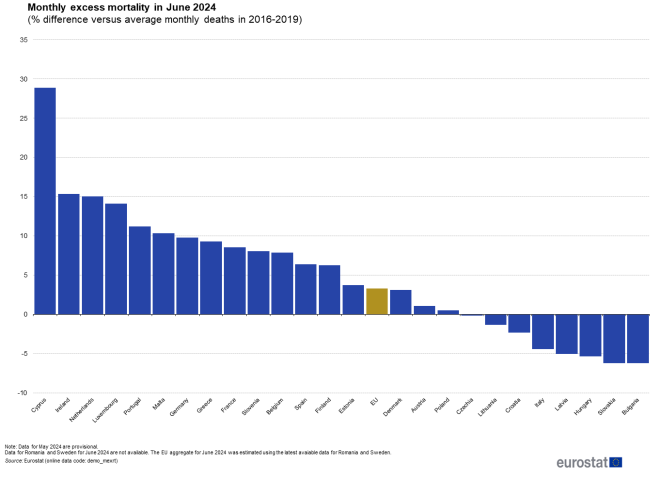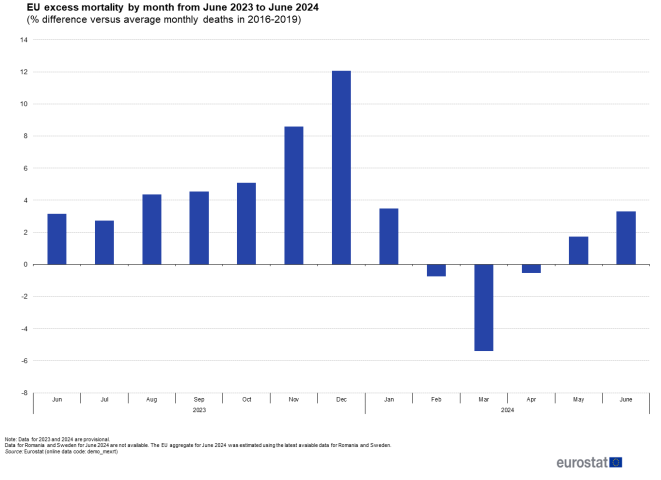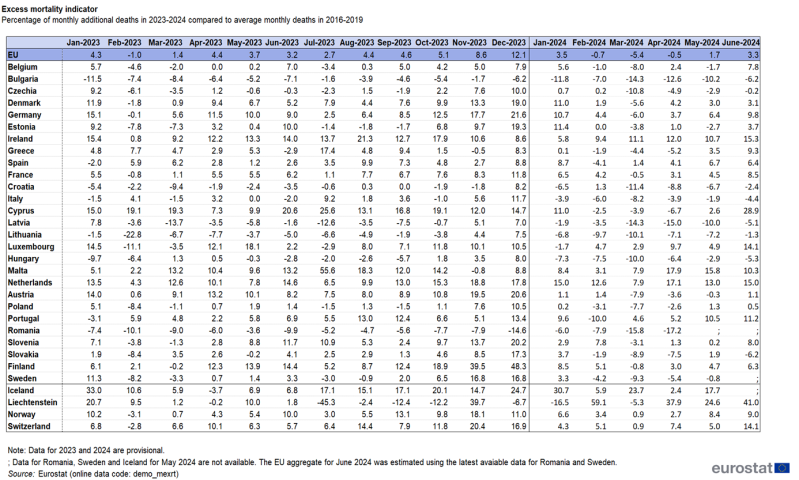Ireland continues to record some of the highest excess death rates across the European Union according to date from Eurostat – with a rate of excess mortality of 15.3% recorded in June 2024, putting this country in second highest position across the bloc, behind Cyprus and just ahead of the Netherlands.
In June 2024, excess mortality continued to vary across the EU, the European Commission’s statistical office said, releasing data that showed the excess mortality rate was positive in 19 EU countries and negative in 8 countries.

“In June 2024, the highest excess mortality rates were in Cyprus (28.9%), Ireland (15.3%) and the Netherlands (15.0%),” Eurostat said. The rate of excess deaths across the bloc moved between 3% to 12% between June 2023 and January 2024, was negative from February to April, and rose again in May and June.

During the first week of June 2024 (week 23), Cyprus recorded the highest excess mortality rate (31.2%). Malta and Portugal followed with rates of 19.3% and 18.9%, respectively. In the second week of June 2024 (week 24), Cyprus had the highest excess mortality rates among the EU countries with 53.1%, followed by Malta with 19.2% and the Netherlands with 16.3%.
During the third week of June 2024 (week 25), Ireland (20.6%), the Netherlands (19.2%) and Estonia (16.8%) recorded the highest excess mortality rates. In the fourth week of June 2024 (week 26), Luxembourg registered the highest excess mortality rate (35.2%), followed by Ireland with 21.4% and Germany with 16.2% additional deaths.
The data shows that, in the past eighteen months Ireland has repeatedly recorded excess deaths rates that are considerably higher than the EU average. With the exception of February 2023, Ireland has recorded excess mortality rates that are significantly above the average of the bloc – often by a factor or 3 or 4.

Last year, Aontú Leader Peadar Tóibín called on Minister for Health Stephen Donnelly to urgently convene an independent inquiry into the cause of excess deaths in the State, saying his party had “been raising serious concerns over excess mortality for two years.”
“There has been a prolonged period, month after month, where mortality figures have been far in excess of the normal in this State. We have been doing so through debates here, through parliamentary questions and in the media. It is deeply frustrating that the Government has not taken this issue seriously at all over the last two years,” he said.
In addition, Fianna Fáil TD, John McGuinness, who was a member of the Special Committee on Covid-19 Response, said last October he was “beginning to think that the number of deaths is unusual and, therefore, we should examine that and try to understand what is the cause of that.” He also said that the number of young people dying in his county shocked him.
The Kilkenny TD said that he believed the number of deaths was “unusually high”, adding that it was “important that the Department of Health, the Government, and any other Department, should examine this to determine why and to learn from what has happened in the past.
“If we do not do that, we could be just storing up a problem for the future,” he said.
Some commentators point to Ireland’s rapid population growth, mostly from immigration, and an increase in the number of older people living here as impacting on the excess mortality rate.
In June, a study published in the British Medical Journal on Public Health claimed that the role of “covid containment measures”, and of covid vaccines, in relation to large numbers of excess deaths were some of the factors that need further investigation.
Eurostat says that excess mortality refers to the number of deaths from all causes measured during a defined period, above that which was observed in the baseline period. The excess mortality indicator takes the number of deaths from any cause in a given period and compares it with a historical baseline from previous years in a period that was not affected by the COVID-19 pandemic. In this case, the baseline consists of the average number of deaths that occurred in each month during the period 2016-2019. The higher the value, the higher the number of additional deaths compared with the baseline. A negative indicator shows that fewer deaths occurred in a particular month compared with the baseline period.
This indicator, which is part of the European Statistical Monitor, provides a comprehensive comparison of additional deaths among the European countries. It provides a general measure of mortality because it includes all deaths regardless of their cause.
The excess mortality indicator is based on a data collection for which National Statistical Institutes from the European Union (EU) and the European Free Trade Association (EFTA) have transmitted weekly deaths data to Eurostat on a voluntary basis since April 2020. The weekly deaths dataset that Eurostat publishes regularly is used to compute the monthly excess mortality indicator by mapping the deaths of each week to a full month. The data covered in this analysis include all deaths that have occurred since June 2023.